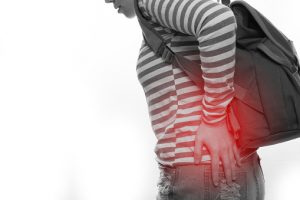
This is the case with back pain and kidney pain. Both present very similarly but have completely different causes. Knowing the symptoms, triggers, and characteristics of these conditions can help you differentiate the two.
Difference between kidney pain and back pain
Back pain is signified by pain experienced anywhere in the lower back or buttocks. Kidney pain, on the other hand, is also experienced in the back, but it usually occurs in the portion between the ribs and hips called the flank.
The severity of back pain changes throughout the day. Kidney pain is usually constant, displaying a pain that is sharp in nature or sometimes dull. The point is that kidney pain does not fluctuate or get better until the problem in the kidney is treated.
The location of back pain also varies. It may extend to the neck, upper back, or remain in the lower back, depending on the site of injury. Varying degrees of pain are also used to describe back pain, with “acute” being back pain that exists for four weeks, “sub-acute” being four to twelve weeks, and “chronic” lasting more than 12 weeks.
Kidney pain is typically classified as being severe or minor, as the different causes can lead to a varying severity of pain. Kidney stones, for example, will produce a severe flank pain possibly associated with nausea and vomiting.
Back pain is also known to spread or radiate to other parts of the body, such as the back of the thigh, buttock, calf, or foot. Kidney pain may spread to the lower abdomen and inner thigh.
Kidney pain vs. back pain causes
Back pain may be caused by:
- Sciatica
- Backbone fractures (vertebral body fracture)
- Fracture of pedicle
- Fracture of lamina
- Disc bulge
- Disc herniation
- Spinal stenosis
- Osteoporosis
- Metastatic vertebral cancer
- Paravertebral muscle spasm
Kidney pain may be caused by:
- Kidney stones
- Kidney infection (pyelonephritis)
- Glomerulonephritis
- Kidney cancer
- Renal infarction
Kidney pain vs. back pain symptoms
Despite having pain in a similar location, symptoms that are unique to each condition do exist. Back pain, for example, is most commonly due to a traumatic injury to the bones in the spinal cord. Kidney pain, however, is commonly caused by a physical obstruction within the organ or a bacterial infection. The following are the various symptoms found in each condition:
Possible back pain symptoms include:
- Fever
- Swelling on the back
- Persistent back pain
- Pain traveling down the legs
- Pain reaching the knees
- A recent injury to the back
- Urinary incontinence
- Difficulty urinating
- Fecal incontinence
- Numbness around the genitals
- Numbness around the anus
- Numbness around the buttock
Possible kidney pain symptoms include:
- Fever
- Painful urination
- Blood in the urine
- Nausea
- Vomiting
- Dizziness
- Constipation or diarrhea
- Rash
- Fatigue
- Chills
Kidney pain vs. back pain treatment
Back pain treatment differs significantly from kidney pain treatment, owing to their vastly different causes.
Pain in the back is treated using pain relieving medications along with several types of physical therapy. These include massage therapy, heat therapy, and cold therapy. Rarely, cases of back pain are severe enough to require surgical intervention.
Kidney pain treatment occurs once the source for its occurrence has been located. Kidney stones will employ the use of pain medication along with increased amounts of water ingestion to accelerate the kidney stone. Surgery may be required in cases of particularly large kidney stones. In cases of infection, antibiotics are favored to help eradicate the bacterial infection.
| Difference between kidney pain and lower back pain | ||
|---|---|---|
| SYMPTOMS/SIGNS | PAIN ORIGIN | |
| PAIN | KIDNEY | LOWER BACK (spine, spinal cord, spinal nerves, back muscles) |
| Location | In one or both flanks (the area between the lower ribs and hips) or, additionally, in the upper abdomen | Anywhere in the lower back or upper buttocks |
| Characteristics | Can be sharp and severe (kidney stone), dull (kidney infection) or throbbing, but usually more constant (until it lasts) than back pain | Changes with the body position and the time of the day |
| Triggers | Drinking large amount of fluids (in ureteropelvic junction [UPJ] obstruction)
Usually not triggered by moving |
Moving (in back injury)
Prolonged sitting, lying, standing (sciatic pain) |
| Relievers | No typical relievers, except treating the underlying disease | Walking (in pinched nerve)
Resting (in osteoarthritis) |
| Pain radiation | To lower abdomen, groin, inner thigh (in urinary stones or kidney infection) | To buttock, back of the thigh, calf, foot, toes on one or both sides (in sciatica) |
| ASSOCIATED SYMPTOMS (sometimes) | Fever
Nausea, vomiting, anorexia Excessive urination (polyuria) Cloudy or dark urine Burning urination Body swelling (edema) |
Numbness or tingling in the foot or toes (one or both sides) |
| SIGNS | ||
| Visible changes | None (in most cases)
Visible mass in one flank (in a large kidney tumor) or in both flanks (in polycystic kidney disease or hydronephrosis) |
Bruise (in back muscle injury)
Bending or limping (in spondyloarthritis or due to pain in pinched nerve) Curved spine and uneven hips (in scoliosis) |
| Tenderness to the touch | Only sometimes, and usually limited to the area over the kidney | Over or near the spine (in spondylitis)
Anywhere (back injury, muscle strain) |
| Palpable changes | Rarely, a lump in kidney tumor or hydronephrosis, otherwise none | Often, muscle tightness as a reaction to pain |
| More details | Symptoms of the kidney pain depending on the cause | |